The Influence of the Group Upon Association and Thought
Floyd Henry Allport
Harvard University
INTRODUCTION
If social psychology is to achieve the title of an independent science, it is high time that its many speculative theories and crude generalizations be subjected to experimental methods. The data of this science, it appears to the writer, may be for convenience subsumed under two heads, viz.: (I) the behavior of an individual in direct response to social stimulus, that is in response to some form of behavior in others, and, (2) behavior which is the response to a non-social stimulus, e.g., a column of figures to be added, or a meal to be eaten, when such response is modified by the presence and actions of other persons. Responses to direct and incidental social stimuli are, in brief, the two classes of data for social psychology.
The following experiments bear upon certain problems of the second class of data mentioned. The method employed was to compare the mental processes (in this case association and thought) of the individual when alone with his reactions to similar and equivalent stimuli when a member of a "co-working or co-feeling" group. In this manner the part played by incidental or contributory social stimulation was determined.[1]
(160)
General Method.—It was considered advisable to eliminate all incentives to rivalry which were not inherent in the very nature of the situation (i.e., individuals working on similar tasks in one another's presence). The subjects were instructed not to regard their work as competitive; overt comparisons between individuals were also prohibited. The time given for the tests was constant, hence no one subject finished before the others. In this way rivalry, which is a distinct social problem and which should be studied separately, was reduced to its natural minimum. Each subject, however, was instructed to acquire the attitude of doing his best in both the group and the solitary work.
The subjects were arranged in groups, containing from 3 to 5 subjects each. The groups had no changes of personnel during a whole experiment. The subjects were upper class-men and graduate students in psychology at Harvard and Radcliffe Colleges. They were 26 in number, though not more than 15 were used in any single experiment. There were 24 men and 2 women. In age they ranged from 20 to 40 years, 26 being the average age.
In the group work the subjects were seated one on each side of a table 3 feet by 5 feet in dimensions. In groups of 5 two subjects sat at one of the longer sides. The same seats were retained by subjects throughout the course of an experiment. Care was taken to secure conditions, such as type of table, light, air, seating of the subjects, etc., in the rooms used for solitary work comparable to those conditions in the room where the subjects worked as a group.
The free chain associations which were to be written were started by a stimulus word, for example 'building' or 'laboratory,' written at the top of a sheet of paper given to each subject. The same stimulus words were employed in the two conditions, T and A.[2] It was also emphasized in group work that the same stimulus word was given to all. It is not believed that the presence of the experimenter in the group work materially affected the results of the social influence.
In all experiments except the first constant intervals of
(161) time were given, in the group by spoken signal, and alone by buzzers placed in each room and tuned down to inobtrusive intensity. Control tests were given in the group, using the buzzer for signals in order to determine whether the buzzer itself played a part in the results. No difference was found in the average, between group tests given by the buzzer and those given by verbal signal. The writing materials (pen, pencil, etc.) used by each subject were kept as constant as possible throughout the experiment.
EXPERIMENT I
Free Chain Association
1. Procedure.—The first experiment, introductory in character, was the only one in which the amount of work was constant, and the time required to finish was taken as the objective result for each subject. Sheets of paper were ruled for writing 100 words. Three tests were given within the hour. Only one group, consisting of but 3 subjects, was used for the experiment. The experimental hour came once per week, and the experiment lasted about 12 weeks. There were weekly alternations of the social conditions, together (T) and alone (A).
The papers were placed before the subjects face down. At the signal they were reversed and the subjects glanced at the word given at the top and proceeded to write their free associations one below the other. The writing of the successive words of sentences or phrases was prohibited as was also the serial association of numbers. While working together the time for each subject was taken by the experimenter; when working alone each subject timed himself with a watch or stopwatch. A rest of three minutes was given between test sheets. Immediately after the completion of each test, both together and alone, the subject was required to mark with distinguishing symbols certain kinds of ideas, as follows: (I) Personal associations (ego-centric), that is, words related directly and intimately with the subject's own past as experience not likely to play the same part in another's association trends; and (2) words which were written without
(162) discoverable connection with any of the preceding words, that is, 'free-rising ideas.'
Treatment of Data.—In the following pages the term 'social increment' is used to indicate a gain in the average quantity of work done in the group over the average done alone. 'Social decrement' indicates a loss in quantity in the group performance. Corresponding gains and losses in quality of the work in the group are termed 'social supervaluents' and 'social subvaluents' respectively. The social increments, decrements, super- and subvaluents, are always expressed as a percentage of the average quantity or quality of the work done alone.) In this experiment the individual social increments or decrements are given on the right in Table I.
The results expressing the social influence upon the kind of associations (personal, objective, etc.) were to meager to admit conclusions. They are therefore omitted for this first experiment.
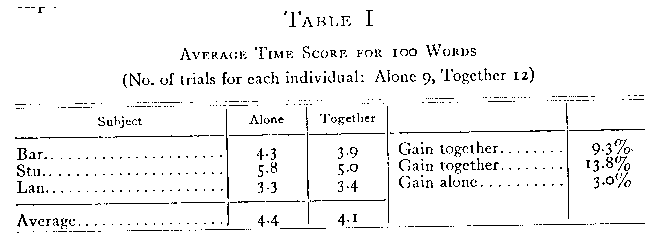
3. Discussion of Results.—Two out of three subjects have a social increment. Both of these increments were much greater than the social decrement of the other subject. For the group there was an average gain in time over solitary work of three tenths of a minute. The first rough indications therefore point toward an increased number of free associations produced in the group.
EXPERIMENT II
Free Chain Association
1. Procedure.—The study of free associations under the social influence was now continued using a larger number of subjects and tests. The groups used all came twice within a
(163) week, the experiment lasting three weeks. There were 15 subjects arranged in 3 groups of 5 subjects each. It was decided to use fairly frequent alternations of the conditions T and A, thus equalizing effects of practice. One group (C) underwent alternations of "together" and "alone" on the same day: sometimes two and sometimes four alternations. A combination was used of the sequences T A T A (or A T A T) and A A T T. If the tests of a certain day began with T and ended with A, those of the following day would begin with A and end with T. The entire series moreover began with T and ended with A. Hence the initial lowering due to newness of the task and the final possible increase due to practice would favorably affect only the score for work done alone. The other two groups (A and B) changed their social condition on successive days. Group A began with a day in T and ended the series with A; group B, as a check, began the series with A and ended with T.
The routine of this experiment had one important difference from that of the preceding. The time was now the constant factor, and the number of words written was the measure of the association process. The interval of each test was three minutes, given with a suitable preparatory interval, by voice in the groups, and by buzzer when the subjects worked alone in separate rooms. A short rest period was allowed between tests.
Another important variation was the division of the work of each test into three periods of one minute each. After one minute of the time had elapsed the experimenter (in the groups) directed "draw line," whereupon each subject quickly made a line under the word he was then writing or had just written, and then continued with his work. This was repeated at the expiration of the second minute. When the subjects worked alone these signals for the divisions were given by short strokes of the buzzer. The rooms of the subjects when working alone were interchanged from day to day in order to obviate the effect of the peculiarities of any one room upon the work of a subject.
To the two types of associations required to be marked in experiment I. were added two more, viz: (1) words, other
(164) than the first, suggested mainly by the stimulus word; and (2) words suggested by the immediate surroundings. Introspection was required immediately after each test together with a rough estimation of the degree of the rivalry consciousness expressed on a scale of O to IV. In all other respects not mentioned the procedure was the same as that in experiment I.
2. Treatment of Data.—The individual tables are omitted because of lack of space. Table II. presents the individual averages. Practice effects at the beginning which appeared in the individual records have been eliminated from the averages by the following rule. In the first day's work (group A and B) all tests which are lower than every single score made in tests on later days are ruled out.
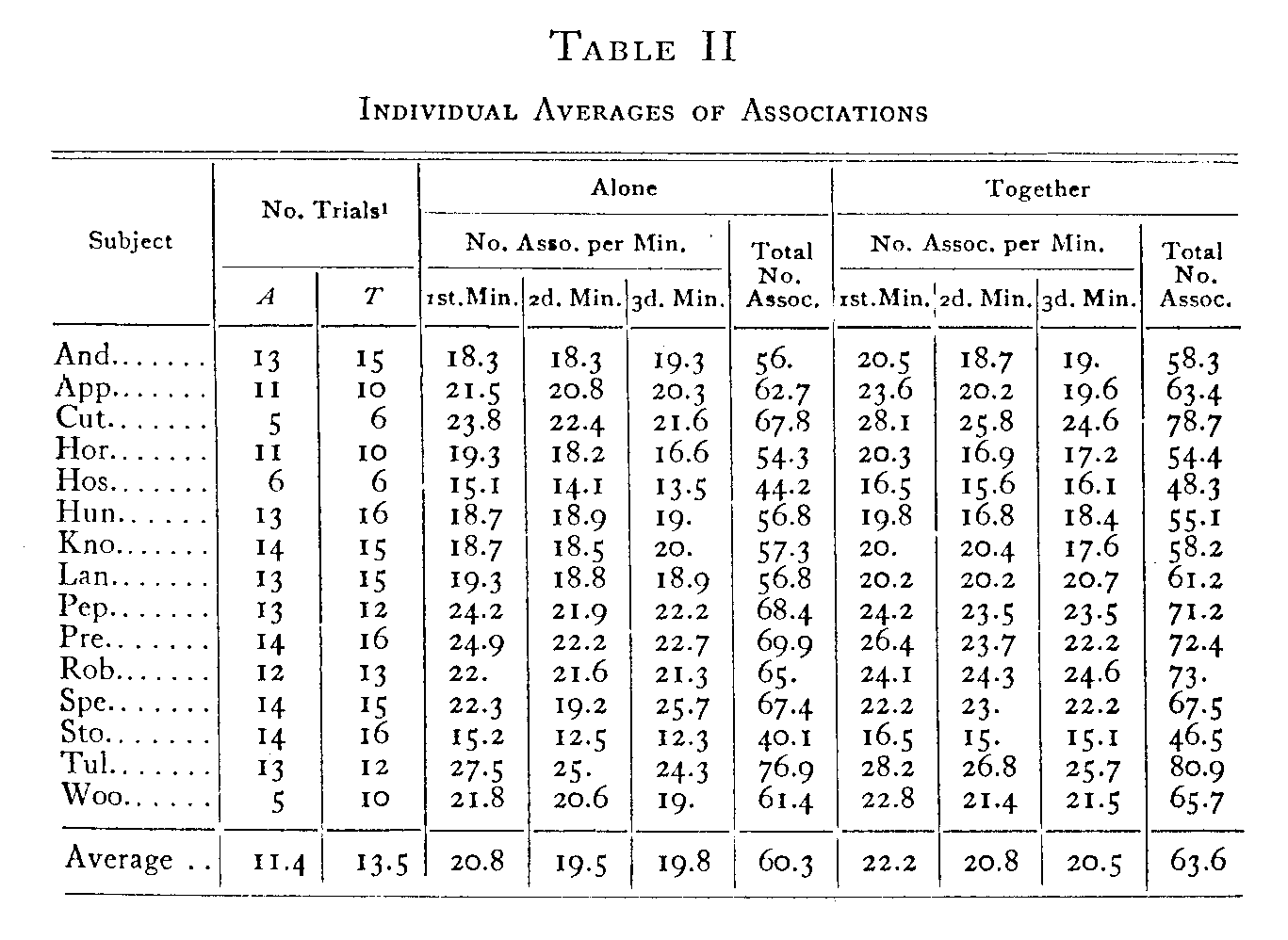
3.Discussion of Results. (a) Quantity of Associations.—Table III presents the average number of associations, together and alone, for each subject, together with the per cent. of gain under the social condition to which it belongs. We find our first experiment amply verified. 93 per cent.
l Exclusive of the trials eliminated owing to effect of practice of the subjects (14 out of 15) produce more associations in the group than they produce alone. The social increments are not large, but their preponderance is conclusive. Cut, Rob, and Sto have considerable social increments (from 12 per cent. to 16 per cent.). The average social increment also of the 14 is twice as great as the social decrement in the case' of the one exception to the favorable group influence, Hun. The number of associations produced by all subjects together is also slightly greater than their average alone (63.6 to 60.3).
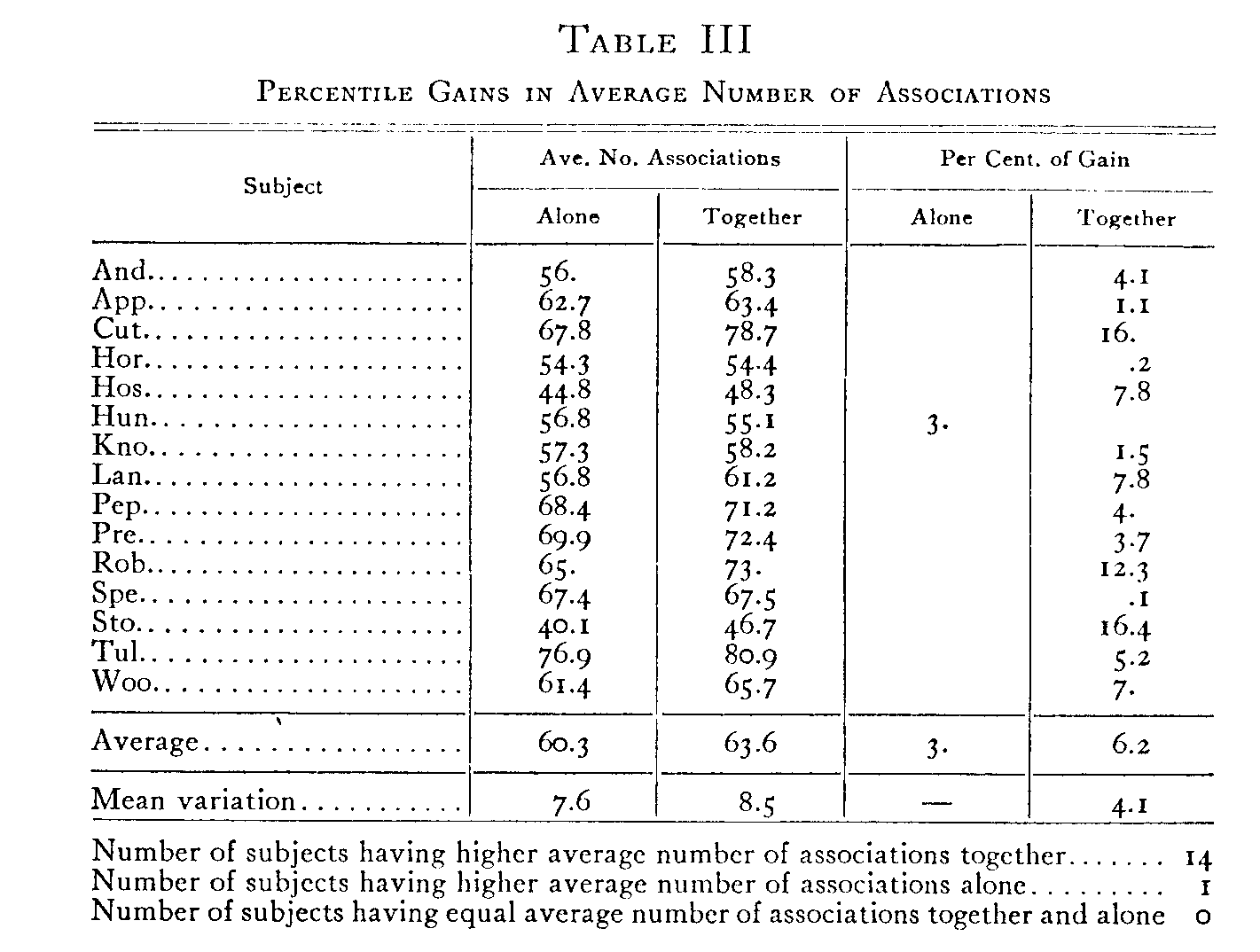
The mean variation among the subjects is higher, relatively to its mean, in group work than in solitary (8.5 compared with 7.6). Hence we find increased variability accompanying a social influence toward increased mental activity.
Let us now consider the distribution of the social increment. The question proposed is whether the increase due to the presence of the group was equally distributed, or whether it occurred chiefly at the beginning, the middle, or the end of the three-minute period. The record of each subject in the
(166) three minutes is shown in Table II. We may compare the results of the three-minute periods both in number of subjects who have social increments in those minutes respectively, and also in the percentile value of the gain in group work shown in the average of all subjects in the three minutes respectively. This latter comparison is taken from the aver-ages at the foot of Table II. We may speak of this gain as the 'group social increment.' Table IV. presents the above relations.

In both proportion of subjects having a social increment and in the amount of the increment itself, we thus find that the superiority of the group condition in speed of associations exists throughout the test, but is greatest in the first minute and least in the third minute. The second minute is not far below the level of the first, the drop in increase due to the social influence coming well toward the end of the task.
If we compare the three one-minute periods with each other in the two social conditions separately (Table II.) we find the following. The averages of all subjects alone (20.8, 19.5, and 19.8) indicate a drop in the second minute, followed by a slight rise (probably an end spurt) in the last minute. The averages together, on the other hand, (22.2, 20.8, and 20.5) form a steady decrease to the end. This result suggests that the effect of the group is at first a stimulating and later a steadying one.
Another possible interpretation seems to be that during the first minute when the associations come with great facility, the social influence counts for a relatively greater addition of speed than toward the end of the test when, through fatigue and comparative exhaustion of complexes and vocabulary, the facility of writing associations has de-
(167) -creased. Under difficult conditions therefore being alone. tends to favor concentration. Group work on the other hand contributes no such benefit to the final and more difficult stages of the task.
(b) Quality of Associations.—The four general types of association, mentioned under procedure, were counted in each individual test. The average number of each type per test for each subject, in group and solitary work separately, is given in Table V.
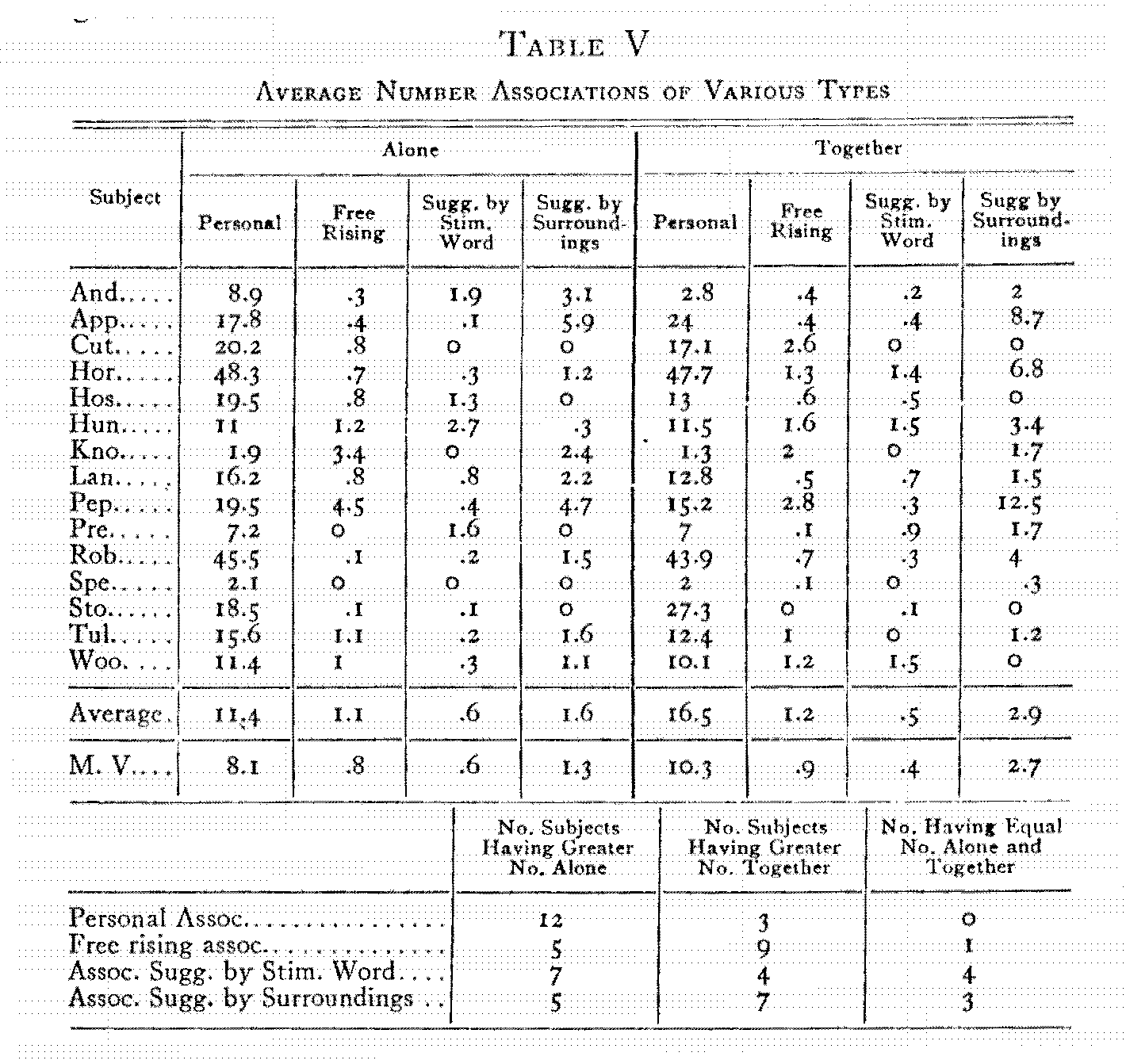
The first type, and the one yielding the clearest result, is that of personal associations. 8o per cent. (12 out of 15) of all the subjects wrote down more personal associations alone than together. There is evidently some sort of attitude assumed by the individual in the group which takes him 'out
(168) of himself' and directs his ideas toward outside objects, and as we shall show later, to the actual presence of the others. In the group we are inclined to expand in our thought; we become objective rather than egocentric, present rather than retrospective.
Secondly, words suggested by the immediate surroundings appear to be more numerous in the group than in the solitary condition. If we consider the average of all subjects, the tendency is marked, for the average together is almost twice as great as that alone (2.9 to 1.6). Individuals considered, we find that 3 show no tendency either way while 7 produce more words relating to the surroundings in the group, and 5 produce more alone. Hence we find that an environment of active persons is more likely to intrude upon one's trend of thought than an environment of mere space and furniture such as in the solitary condition.
The third type of associations, the 'free-rising' ideas, also occur more frequently in the group. The averages give only a slight increase for the group work; but the individual records show that 64 per cent. (9 out of 14) of persons affected either way produce more of these spontaneous ideas in the group than they do alone. It is possible that 'free-rising' words result here from that greatly facilitated flow of associations characteristic of work in the group.
Finally, we may note that words, other than the first, suggested mainly by the stimulus word are more numerous in the solitary than in the group condition, as shown by the average of the individuals and especially by the number of individual cases (ratio of 7 to 4). The explanation, though obscure, may lie in the longer persistence of the original trend of thought in the solitary than in the social setting.
(c) Correlations.—There are, finally, several correlations to be described. The first is that between the rank of individuals in speed of association and their rank in regard to the favorableness of the group influence on their work. We find, in harmony with the results of other investigators, and with the writer's own study of attention and mental work, that there is an inverse correlation—though here it is a very small
(169) one (-.12).[3] Important exceptions act to reduce the index of correlation: for example, Cut is high in both respects; Hor is low.
A further correlation was developed to indicate to what extent the social increments were due to that irreducible minimum of conscious rivalry characteristic of all co-working. It was found that only 3 subjects experienced no rivalry at all. The remainder, 13, all recorded on the average of all tests more rivalry in the group than alone. The ratio of this increase was 1.9 to 1. The correlation between this excess of rivalry consciousness 'together" and the size of the social increment was found to be so slight as to be negligible. It was .23. There was also no correlation (.02) between the subject's report of mere vividness of consciousness of the group (or its absence) and the amount of the stimulation to speed afforded by the group.
(d) Introspection.—There was substantial evidence from the introspection of awareness of being "drawn out" by the presence of the group, so as to produce associations of a more objective type, as previously shown in the results. As to the group influence on speed, two clear cut factors appear in some cases in the same report. The first is an impeding-,., influence owing to sensory distraction, emotional factors such as over-stimulation in rivalry, self-prejudicial comparisons with others, and the like. The second and stronger factor—is facilitation. Numerous stimuli indicative of the rapid work of one's neighbors serve as a drive to greater effort. The principle here involved is probably that commonly known as "suggestion" or "imitation" in superficial accounts of group and crowd phenomena.
EXPERIMENT III
Free Chain Association
1. Procedure.—The method used in Experiment II. was considered imperfect on the following ground. Associations
( 170) are as a rule produced more rapidly than they can be written, and therefore the writing down of each one in turn does not allow the most rapid play of which the process is capable. The results may measure, not the associational ability itself, but simply the speed of writing. A short experiment was accordingly prepared in which the subject was to write down, not every word, but every fourth word which occurred to him. With a little practice the subjects rendered automatic the rhythm of writing every fourth word only. The division of the three minute period into 3 parts was not made in this experiment. The subjects and grouping were the same as for experiment II. The tests were presented on two days, within the period of a week. The sequences of alternation were as follows, the horizontal line dividing the work of the two days: the social increments is very much greater than the average of the social decrements.
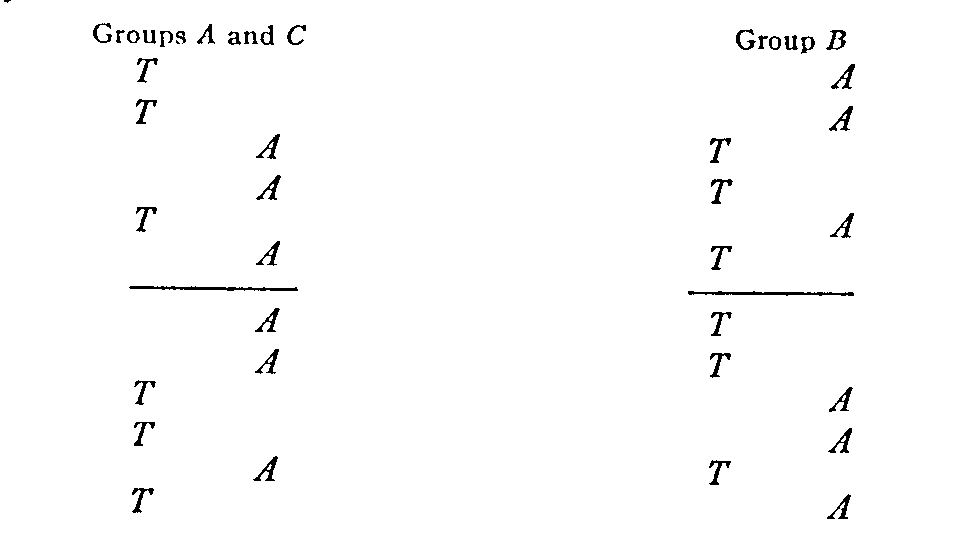
2. Treatment of Data.—The number of associations written in each test was multiplied by 4 and tabulated. The record of Tul is omitted owing to insufficiency of data. The result of the first test was eliminated whenever it was found to be lower than the score of any succeeding test under the same social condition. Table VI. presents the usual summary of individual records.
3. Discussion of Results.—The results shown in Table VI. indicate again a distinct though less pronounced advantage for work done in the group. Two subjects show a social equivalence. Of the rest 66 per cent. produce more associations in the group. The group average for the associations together is greater than the average alone, and the average of
(171) the social increments is very much greater than the average of the social decrements.
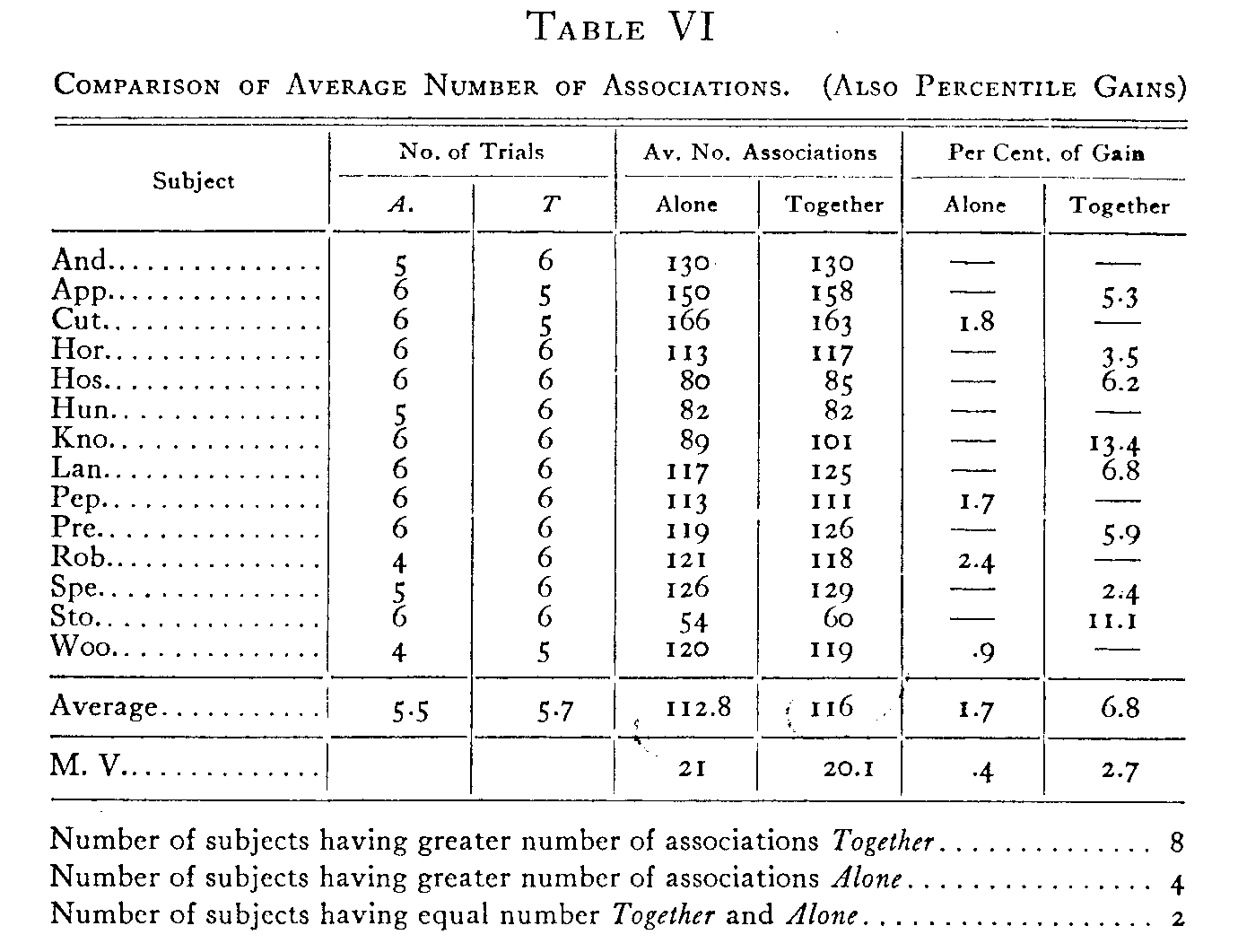
The number of trials was too small to allow the mean variation to carry much significance. Comparing however the mean variation of the social increments with that of the decrements, we find distinctly more variability in the former. In other words the social influence, when it affects workers favorably, affects them also in very varying degrees. Considering, not increments, but actual number of associations written together and alone, the variability both relatively and absolutely is greater alone.
The correlation between the individual's ability to associate rapidly and the size of his social increment is still inverse, and somewhat greater than usual (-.53).
The consciousness of rivalry was in most cases slight in amount, and occurred in slightly over half the individuals. The effect on the work however was perhaps noticeable. Between excess of rivalry together and the size of the social increment there was the small correlation of .41.
(172)
EXPERIMENT IV
Free Chain Association
I. Procedure.—Since the conclusions of experiment III. were based on rather few results the experiment was repeated using fewer subjects but about twice as many tests. This time no stimulus word was given: the subject thought of his own initial word. Another difference was that every thirds word, instead of every fourth, was written. The subjects numbered eight and were divided into two groups of 4 each. The experiment covered about five weeks, each group being tested once per week. There was an average of four tests in each hour that the groups were tested. The sequence of social conditions employed a combination of alternations in successive days and alternations within the same day. Group A began with T, and group B with A. (In tabulating the number of words set down was the actual number of associations written. The individual summaries are presented in Table VII.)
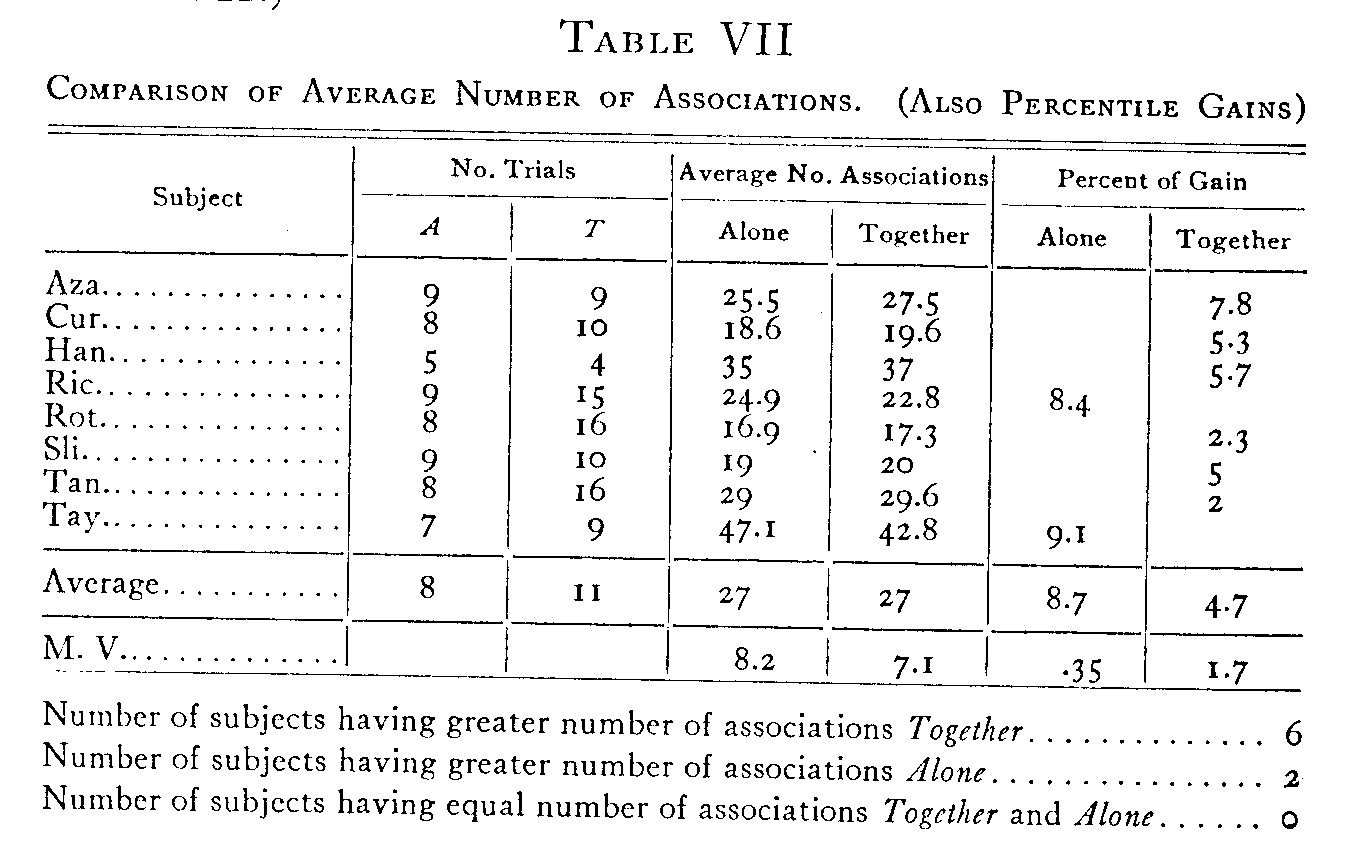
3. Discussion of Results.--The general results of this experiment verify those of the one preceding. A somewhat greater proportion of subjects (75 per cent.) have a social increment. This proportion is still, however, less than the
(173) 93 per cent. who attained social increments in the mechanical task of writing down every associated word.
The average increment is less than the average decrement owing to the unusually large decrements of the two subjects who did better alone. This fact probably justifies the conclusion of individual differences, the two subjects, Ric and Tay, requiring the solitary condition for their best efforts. Work upon reasoning (see Exp. VI.) corroborates this tendency in the case of Ric.
The mean variation agrees with that of experiment III. in showing a greater variability in work done alone. (The mean variation of increments and decrements is here without value owing to the small number of cases.) We should take into account here the part played by rivalry in producing the social increment of the results. The correlation in this experiment is very high (vide infra). Where rivalry is effective (i.e., not merely present) in group work there is a tendency toward uniformity among the members.
The correlation between the subject's associative ability and the degree to which his work is increased by the group is still inverse, though small (-.19). Here also we find toward the extremes conspicuous exceptions to the inverse correlation.
We noted in our last experiment a slight tendency for conscious rivalry to become a cause, or at least an accompaniment, of the group stimulus. We now find that tendency verified. There was found a positive correlation of .89 between the excess of consciousness of rivalry together and the size of the social increment. Rivalry therefore plays a greater part in the speed of associations for the most part merely thought than it does in the case of associations whose flow is limited to the speed of their writing. This result is doubtless due in part to the readier improvability of the mental association speed than of the speed of writing.
The significance of inhibitions in producing the solitary decrement is suggested by a positive correlation between an excess of inhibitions alone and the tendency to improve in the group. The correlation found (.76) indicates that the low
(174) level of the subject's work alone is connected with his
inhibitions—these inhibitions occurring for him more numerously in the solitary
than in the group condition. Alone there is evidently a blocking, traceable
perhaps to a lapse of attention or effort, or to forgetting "where one is."
Under the stimulus of the group the response receives greater facilitation.
EXPERIMENT V
Controlled Association—Contrasted Occupations
As a minor digression from the usual setting of the experiments, an attempt was made to compare not the work of the subject alone with his work in the group, but to compare his accomplishment, always in the group, in tasks similar with that in tasks opposite to the occupations of his fellows. Half of the group were seated at one side of the table and instructed to write words all bearing upon one specified topic (e.g., winter), while the other half, seated opposite, wrote words all bearing on the opposite theme (summer). The solitary condition was not used in this experiment.
A test pair consisted of two performances upon a given theme, one the result of working in the manner described above, the other produced at another time when all members of the group wrote upon the same topic. Only about three such test pairs were obtained from each subject. Their total for the experiment was 35. Of these pairs 19 showed an excess of associations written in the common occupation over those written in contrasted work. In only 16 pairs was the advantage with the contrasted occupation. The average excess also in the common work was greater (7) than the average excess where it occurred in the contrasted setting (5).
So far as these results go there seems to be an advantage in tasks in which all are working in agreement over work done while pursuing diverse trends of thought. The tests given are however too meager for certainty; they indicate merely an interesting possibility for further investigation.
(175)
EXPERIMENT VI
Thought Process
1 Procedure.—An experiment was finally performed which extended the study of the social influence to the more intellectual functions involved in reasoning. Statements have been made by various writers that this "higher" quality of process is better performed in solitude. Tests of critical and original thinking were therefore devised in the nature of discursive reasoning. Short passages were selected from the works of Epictetus and Marcus Aurelius which admitted of considerable argument, for and against. The task of the subjects was to write down all the arguments, as many and as strong as possible, which they could think of to disprove the point made in the passage given. The epigrams both together and alone were presented in legible handwritten form, one copy to each subject. At the beginning of the group tests it was emphasized that they were all writing on the same statement. The time allowed for writing the ideas in a single test was 5 minutes. A separate passage was used for each test.
Nine subjects were used, arranged in two groups, A and B. Approximately 20 tests were given alone and 20 in the group. The total period covered by the experiment was 2 months. The social condition was changed (from A to T, or from T to A) on successive days. Group A began with T, group B with A. The passages selected naturally varied somewhat in suggestiveness; but it is believed that in a series of 20 a fair uniformity was obtained for the two social conditions. This is still more likely since only two authors were used, and those two are singularly constant in the tenor of their utterances.
1. Treatment of Data.—Each test written was graded as to quality of the arguments proving the negative of the statement. For this purpose the following scale was used. A distinct, clear, and (for the subject) forceful idea going directly to the question received a score of 3. Developments, extensive illustrations of the point made, giving pertinent
(176) opinion of an authority, refining or re-stating the question to remove its logical objections, suggesting an alternative proposition, and the like, each counted 2. Emphatic statements or interjections of rejection, quotations merely stating the opposite, personal aphorisms, repetition of an argument already given, qualification or withdrawal or a former argument, rather irrelevant arguments, and so on, were each scored I. For each subject each type of idea or argument thus contributed its proper score to each test; and by averaging the sums of these scores for the various tests there were found the average individual scores for ideas. These results are presented in Table VIII.
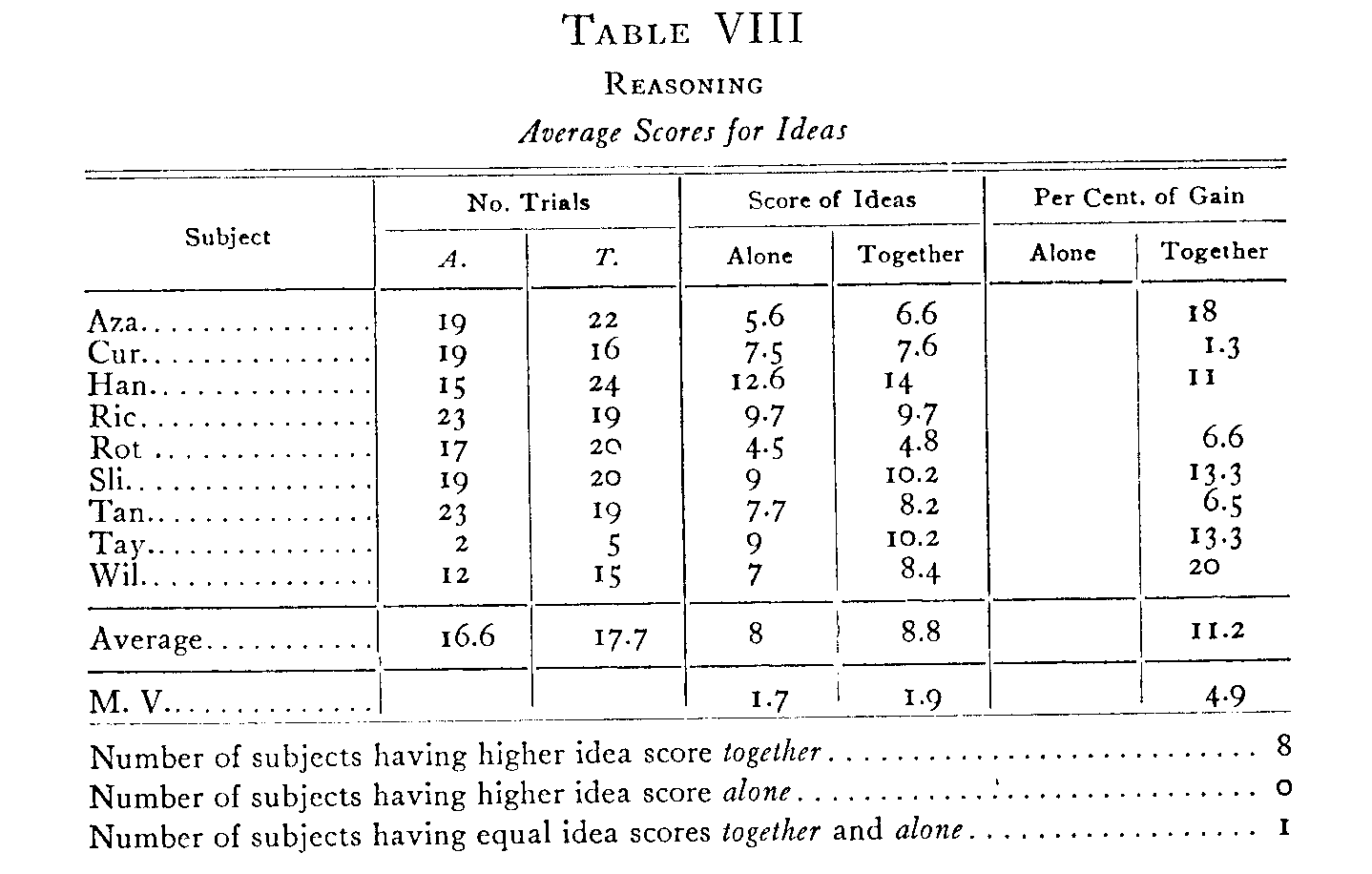
In addition, the total number of ideas of the three types, together and alone, found in the work of each subject, were averaged separately. Table IX. presents this comparison of averages of ideas types. Taking the number of each type as a per cent. of the total number of ideas in the given social condition" (i.e., together or alone), one may compare the relative contributions, together and alone, of the several types to the total idea score for the subject. This comparison is shown in Table X. Finally the words written in each test
(177) were counted, and the average number of words per test for the different individuals, together and alone, was computed. Table XI. contains these averages together with the percentile gains under the proper social condition.
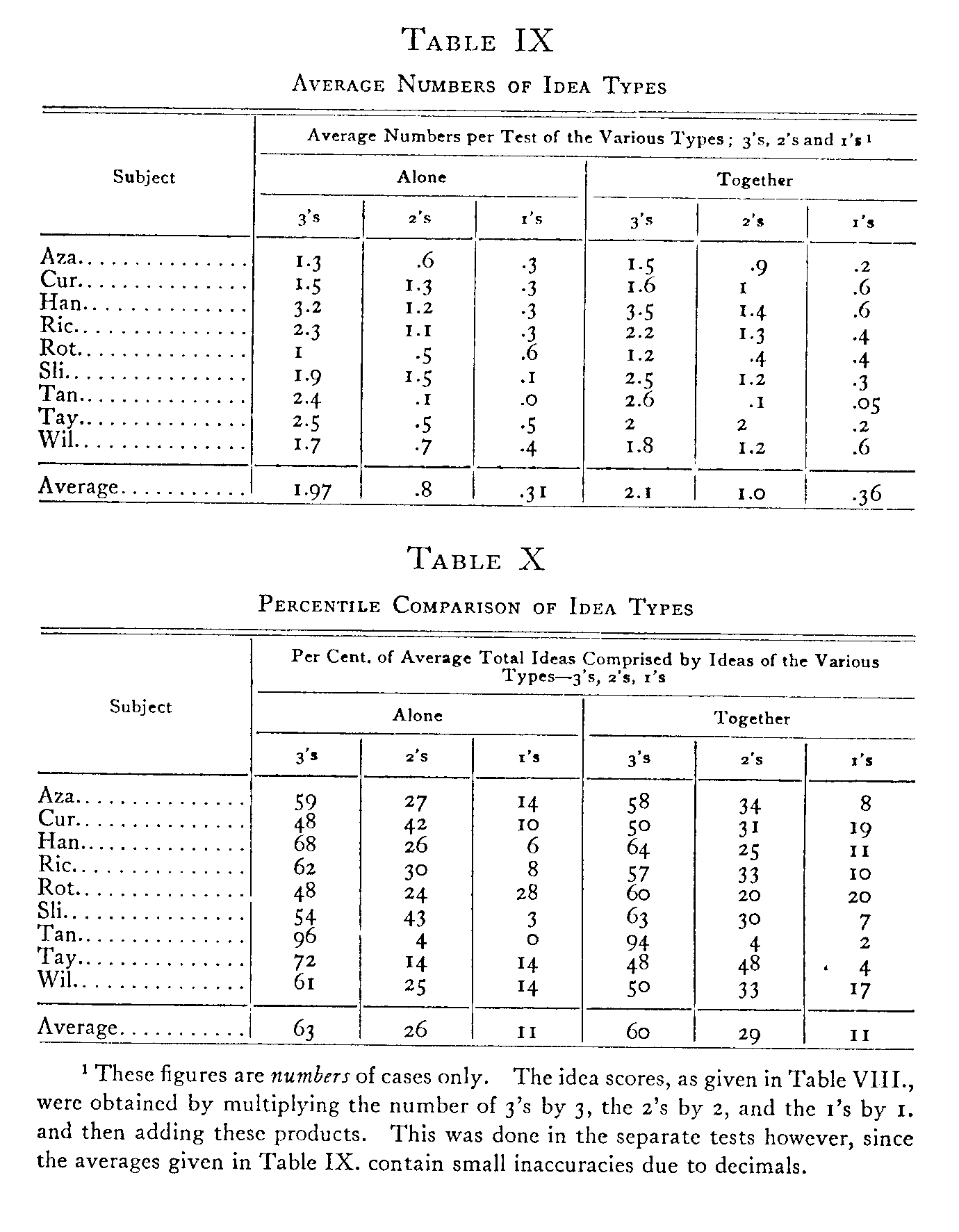
(178)
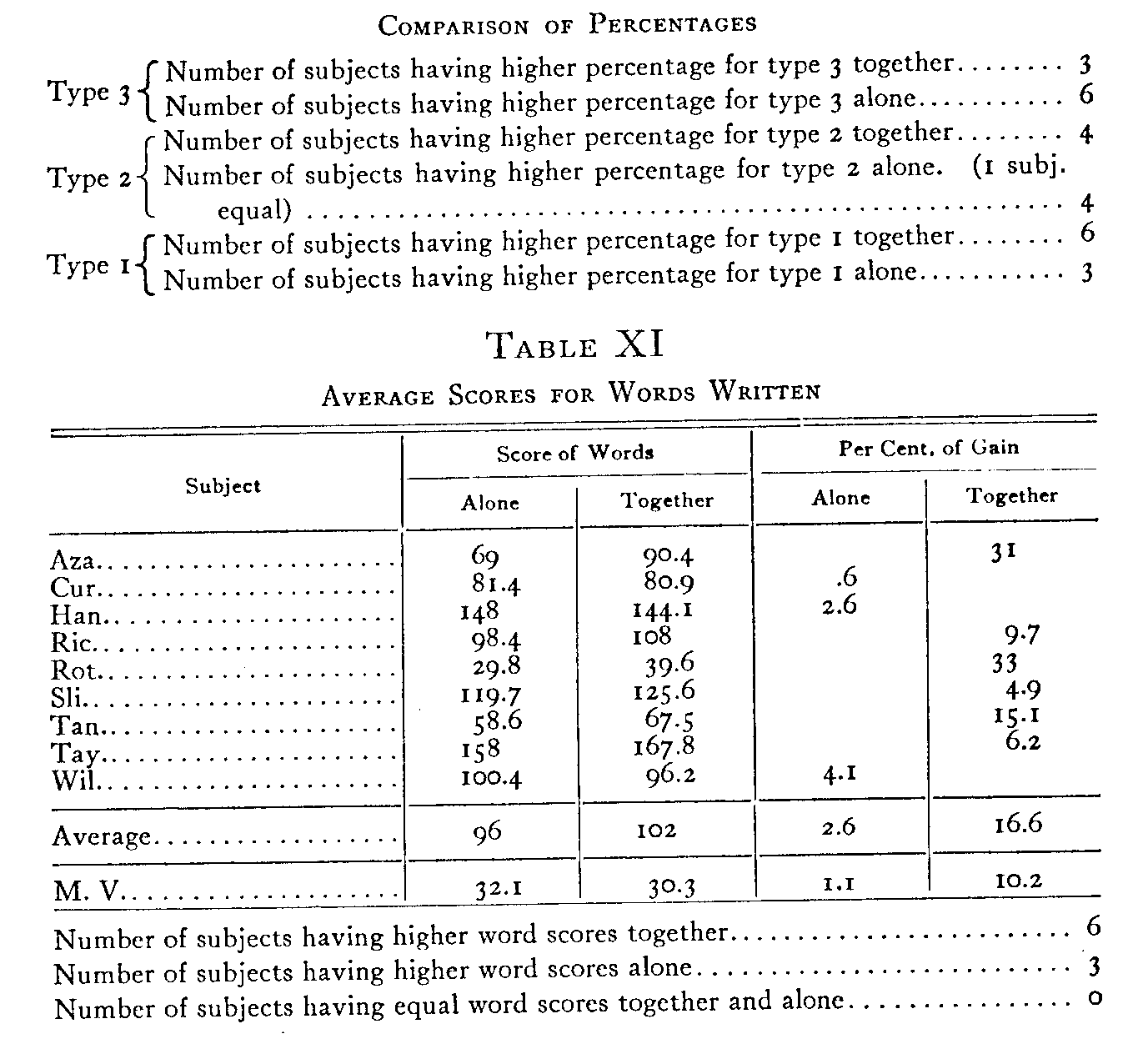
3. Discussion of Results.—From Table VIII. it will be seen that of the 9 subjects used, 1 had equal average idea scores together and alone. The remaining 8 all had higher idea scores when working in the group. The average idea score together for all subjects showed also a social increment: it was 8.8, while the average alone was 8. The individual social increment, generally rather large, ranged from 1.3 per cent. to 20 per cent., 5 out of 9 being above 10 per cent.
Turning to the percentile importance of each idea type alone as compared with its importance together, as shown in Table X., we find that 6 out of 9 subjects had a higher percentage of superior ideas (counting 3) while working alone. The number of the subjects, together and alone, having the higher percentage of "2" ideas was equal. There were (reciprocally to the "3"class) just 6 out of 9 subjects who
(179) had a higher percentage of the lowest type of ideas (counting I) while working in the group. The averages of all subjects, indicate also a higher performance, relatively, so far at least as the proportion of superior ideas is concerned, while working alone. There is thus demonstrated a social subvaluent for argumentative or discursive reasoning. This finding is no doubt in accord with commonly observed facts of life. Who has not been aware, upon retrospection, of the low order of logical value in many arguments given under such a strong social influence as that of political meetings and oral debates? There seems to be a spreading out of our thought rather than a strong output of separate original ideas of logical worth. Group thought is extensive; individual thought is, to some extent, intensive.
May not this "extension" in group thought be also characterized as "wordiness"? It seems quite logical to call it this, for Table XI. shows that 6 out of 9 subjects wrote more words in the group than they did alone. The averages of the individuals' scores also show the group gain in number of words written (102 to 96). A third evidence lies in the excess in the average of the social increments (16.6) over the decrements (2.6). This disclosure is consistent with the results of all previous experimentation on the social influence. There has been throughout a clear increase of the quantitative aspect of mental processes and mental work in the group condition. Our association experiment of writing every word in free thought may be compared with the writing of every word in controlled thought in the present experiment. In both cases every subject but one showed, in the quantity of words written, a distinct social increment.
4. Introspection.—There is some evidence in the reports of the awareness of the social subvaluent in the thought process.
SUMMARY OF CONCLUSIONS
A. THE INFLUENCE OF THE GROUP UPON ASSOCIATION
I. Quantitative Aspects
I. The main result of the preceding experiments on association is the conclusion that the presence of a co-working
(180) group is distinctly favorable to the speed of the process of free association. In various tests from 66 per cent. to 93 per cent. of the subjects show this beneficial influence of the group.
2. The beneficial group influence is subject to variation according to the nature of the task. In the more mechanical and motor requirements, such as writing each word associated, the group stimulus is more effective than in the more highly mental or more purely associational tasks such as writing only every third or fourth word.
3. There are individual differences in susceptibility to the influence of the group upon association. One type, who are nervous and excitable, may succumb to the distracting elements of the group activity and may show either no effect, or else a social decrement.
4. In its temporal distribution the beneficial effect of the group is greatest in the first part of the task and least toward the end of the task.
5. There is a tendency for the slow individuals to be more favorably affected in speed by the group co-activity than the more rapid workers. There are, however, certain striking exceptions.
6. The variability in output among the individuals varies generally with the social influence. Hence it is usually greatest in the group work. A striking exception to this occurs in the tests where rivalry is correlated with the social increment, and where only every third or fourth word is written. Here the variability is greatest in the solitary work. This result is in agreement with that of earlier investigators working on different processes.
7. There is suggestive but not conclusive evidence that the output of associations in a group where all the members are forming associations in the same category is greater than that in groups in which the members are divided in the trend of their associations between opposite or contrasted categories.
II. Qualitative Aspects
8. A greater number of personal associations are produced alone than in the group.
(181)
9. In harmony with this fact is the tendency for subjects to produce ideas suggested by their immediate surroundings with greater frequency in the group than alone.
10. Less clear cut, but very probable, are the tendencies to produce a greater number of " free rising" ideas in the group, and to produce a greater number of words suggested mainly by the initial stimulus word when working alone.
III. Factors in the Social Influence
II. There are two opposing groups of factors in the influence of the social condition upon the association process. They are:
(I) Facilitating Factors:
(a) Facilitation of movement by perceptions or ideas of movements in others near us.
(b) Rivalry intrinsic in the bare social setting of a group working together. Rivalry is well correlated with the beneficial influence of the group in tests of a more mental sort (and less mechanical) such as writing every fourth word only. It is not so correlated when each word is written.
The beneficial effects of the group in experiments where the rivalry consciousness is closely correlated with this influence is less than in experiments where it is not so correlated, but where other factors—for example, motor facilitation—serve as the stimulus of the group.
(2) Impeding Factors : distraction, over-rivalry, emotions. Of the two groups, the facilitating is by far the more important in the total effect upon the work.
12. Beside the comparisons already indicated, we may note the general agreement of our work with that of earlier students in the speed improvement of mental operations, as shown by the quantity of the product, under conditions of working with others.
B. THE INFLUENCE OF THE GROUP UPON THE THOUGHT PROCESS
13. In the highly controlled association of the thought process, as typified in written argument, more ideas are pro-
(182) -duced in the group than when working alone. Again we find an increased flow of thought owing to the social stimulus.
14. Among the ideas so produced, those of superior quality, however, are of relatively greater frequency in the solitary than in the group work. Ideas of a lower logical value are relatively more numerous in the group work.
15. More words are used in the arguments produced in the group than in those produced in solitude.
16. From the above facts, and also from the introspection of the subjects, we may conclude that the presence of the group influences the reasoner toward a more conversational and expansive form of expression. The more intense logical thinking of solitude gives way in the group to extensity of treatment.
17. These results appear to be related to the common observation that work requiring imagination or more concentrated and original thought is best performed in seclusion. There is also a connection suggested with the writer's experiments upon the social influence in attention and mental work.[4] In that investigation, as well as in the present, the social influence was found to improve the quantity but not the quality of the mental performance.